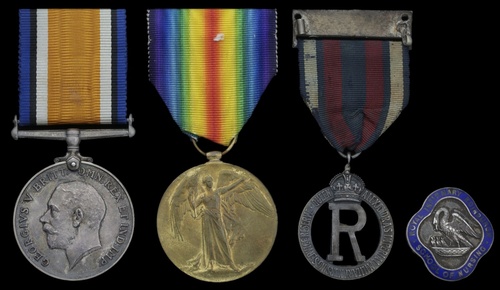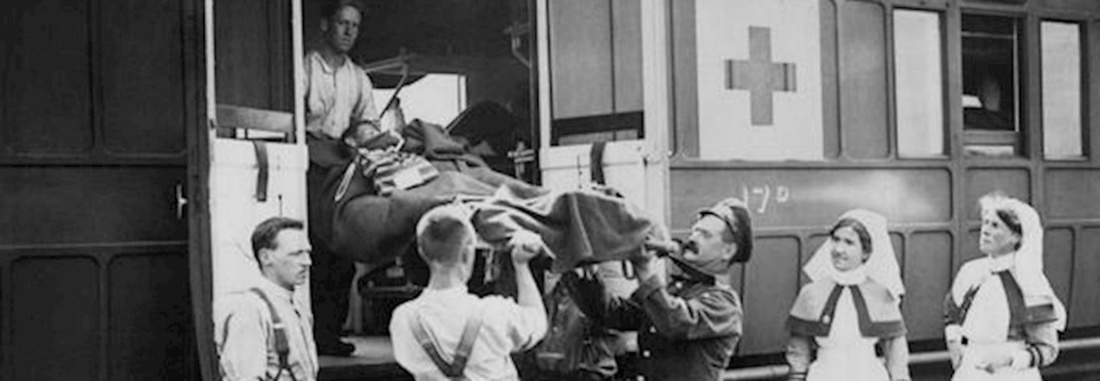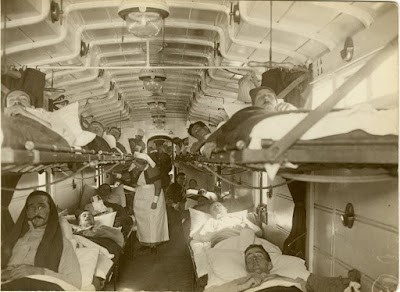Auction: 22002 - Orders, Decorations and Medals
Lot: 94
'That evening, the R.A.M.C. orderlies dared not lift me from the stretcher into a hospital train bunk, for fear of starting a haemorrhage in the lung. So they laid the stretcher above it, with the handles resting on the head-rail and foot-rail. I had now been on the same stretcher for five days. I remember the journey as a nightmare. My back was sagging, and I could not raise my knees to relieve the cramp, the bunk above me being only a few inches away. A German flying-officer, on the other side of the carriage, with a compound fracture of the leg from an aeroplane crash, groaned and wept without pause. Though the other wounded men cursed him, telling him to stow it and be a man, he continued pitiably, keeping everyone awake … '
Robert Graves, poet and scholar, recalls his painful journey in a hospital train on 24 July 1916, his 21st birthday.
A Great War campaign pair awarded to Staff Nurse A. C. Felpts, Queen Alexandra's Imperial Military Nursing Service Reserve
In addition to a succession of appointments at Stationary Hospitals and Casualty Clearing Stations, she served in No. 32 Ambulance Train in 1917-18
Working alongside just two or three fellow nurses, Felpts had to care for up to 500 patients aboard her train, many of them caked with blood and mud and in a critical condition. Throughout each challenging journey, in which patients invariably succumbed to their wounds, she and her colleagues worked with the barest of necessities and no comforts - and under the threat of indiscriminate enemy fire
A fellow ambulance train nurse, Kate Luard, R.R.C., lends moving testimony to the sad nature of their work:
'When you stand off for a few hours from the gruesome details & pathetic streams of broken, dirty, ragged, bandaged cripples that one is occupied with all day it gets more & more unfathomable & heart-breaking. 1500 were disembarked from the trains yesterday & they are still streaming in. One train of bad cases yesterday took 8 hours to unload … '
British War and Victory Medals (S. Nurse A. C. Felpts), together with Edinburgh Royal Infirmary School of Nursing badge, silver and enamel, hallmarked Birmingham 1916, reverse engraved 'A. C. Felpts 1347' and Q.A.I.M.N.S.R. cape badge, silver, hallmarked Birmingham 1916, nearly extremely fine (4)
Annie Clifford Felpts was born in 1884, the daughter of Robert Felpts, of Ulverston, Cumbria, and served as a Staff Nurse with Queen Alexandra's Imperial Military Nursing Service Reserve in France from 2 March 1916.
Ambulance Trains 1917-18
Following postings to 25 and 2 Stationary Hospitals, the latter at Rouen, she joined the nursing staff of No. 32 Ambulance Train in August 1917, and she remained likewise employed until February 1918.
A summary of the ambulance train statistics appears on the History Press website:
'These trains transported the wounded from the Casualty Clearing Stations to base hospitals near or at one of the channel ports. In 1914 some trains were composed of old French trucks and often the wounded men lay on straw without heating and conditions were primitive. Others were French passenger trains which were later fitted out as mobile hospitals with operating theatres, bunk beds and a full complement of Q.A.I.M.N.S. nurses, R.A.M.C. doctors and surgeons and R.A.M.C. medical orderlies. Emergency operations would be performed despite the movement of the train, the cramped conditions and poor lighting. Hospital carriages were also manufactured and fitted out in England and shipped to France.
In the early trains there was often a lack of passage between the coaches and with only a few nurses it was necessary for a nursing sister to pass from coach to coach, whether the train was in motion or not, usually carrying a load of dressings, medicines etc. on her back in order to tend to the wounded on each coach. During the night she also had a hurricane lamp suspended from her arm. The medical staff consisted of three medical officers of the R.A.M.C. including the Commanding Officer, usually a Major, two Lieutenants, a nursing staff of three or four with a sister taking on supervision of the whole train, complemented by 40 R.A.M.C. other ranks and Non-Commissioned Officers.
An average load was 4-500 patients with a large number in critical condition. Often they were transferred to the train still in full uniform in shocking condition caked with mud and blood and owing to the cramped conditions their uniforms had to be cut away. Many journeys were long such as the one from Braisne to Rouen taking at least 2 ½ days. There were deaths on all journeys. The nurses' workload was heavy and they worked under dangerous conditions with the barest necessities and no comforts.
In Kate Luard's first book published anonymously in 1915 she vividly describes in her letters home her experiences working on the early ambulance trains 1914-1915, transporting wounded soldiers back from the Front to hospitals in the base area.'
Nursing Sister Kate Luard, who served in No. 5 Hospital Train, was awarded the R.R.C. and Bar and was twice mentioned in despatches.
Postscript
Annie Felpts went to serve at No. 7 Casualty Clearing Station at Ligny St. Floches in April-September 1918, followed by a final wartime appointment in the Acute Medical Ward of No. 42 Stationary Hospital, where 'she was keenly interested in her work and proved herself a capable nurse'.
On being demobilised in February 1919, she took up a post at the Royal Salop Infirmary, Shrewsbury and she died at Ulverston, Cumbria in February 1968.
Recommended reading:
Diary of a Nursing Sister on the Western Front, by Kate Luard, R.R.C. (1915).
Unknown Warriors - The Letters of Kate Luard, R.R.C. (1930).
https://www.thehistorypress.co.uk/articles/evacuation-of-the-wounded-in-world-war-i/
https://www.dailymail.co.uk/news/article-2605886/Poignant-archive-pictures-ambulance-trains-transported-soldiers-wounded-First-World-War-hospitals-Britain.html
Subject to 20% VAT on Buyer’s Premium. For more information please view Terms and Conditions for Buyers.
Sold for
£320
Starting price
£180









